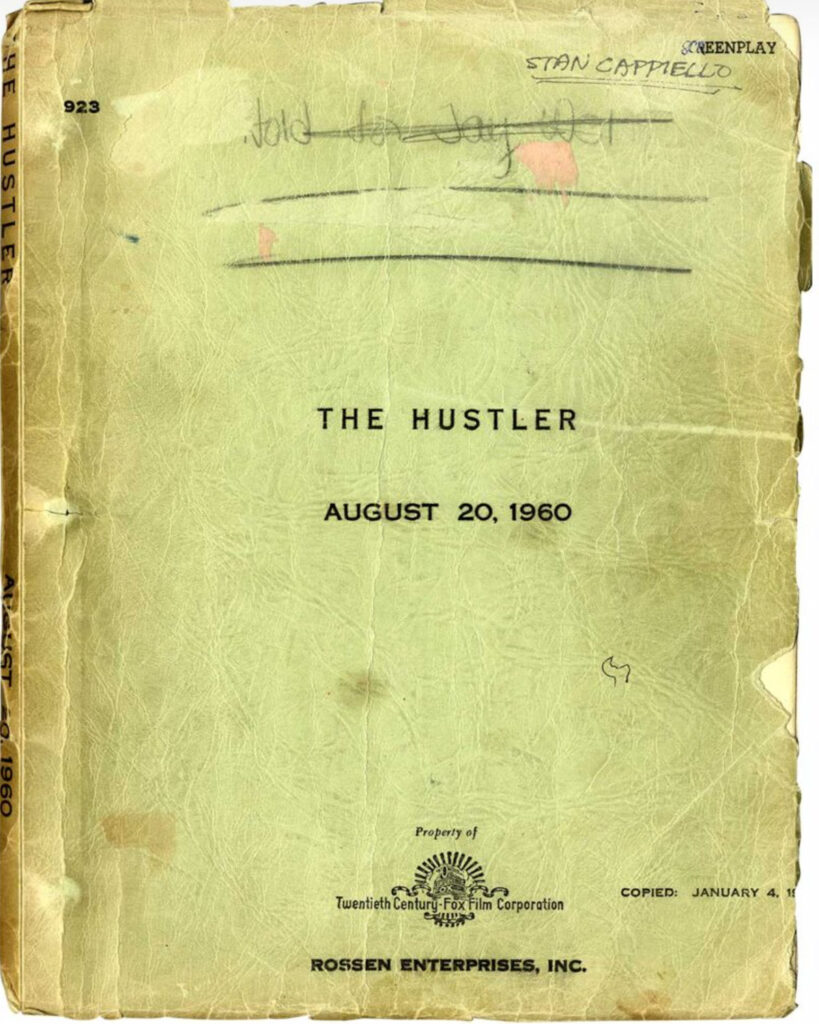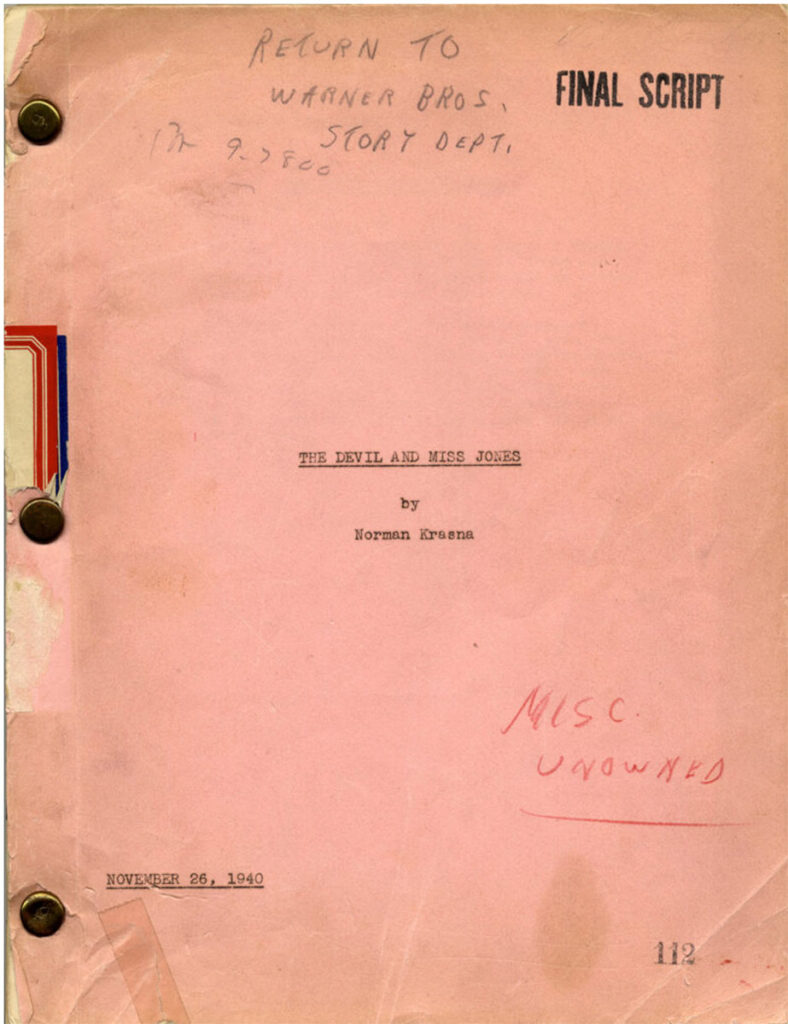
Four Academy Award Winning or Nominated Screenplays
With Academy Award Season about to begin, we thought it might be appropriate to celebrate four significant screenplays that either won or were nominated for an Academy Award. After all, without a bit of imagination and the written word there would be no movies, no Academy Awards and, of course, no Academy Museum of Motion Pictures.
AMADEUS BY PETER SHAFFER
1984 Academy Award Best Writing, Screenplay Based on Material from Another Medium
Second Draft screenplay (Jul 9, 1982) by Peter Shaffer Berkeley, CA: Saul Zaentz Production Company, 1982. Vintage original film script, bound with a metal clasp. Printed wrappers with a die-cut window, 11 x 8 ½” (28 x 22 cm.), 148 pp., just about fine.
AMADEUS is one of the most honored films of all time. It earned a total of eight Academy Awards for the year 1984, including Best Picture, Best Director (Forman), Best Adapted Screenplay (Shaffer), Best Actor (F. Murray Abraham as Salieri), Best Art Direction, Best Costume Design, Best Makeup, and Best Sound. It also earned four BAFTA Awards, four Golden Globe Awards, a Directors Guild of America award, and in 1998, the American Film Institute ranked it 53rd on its “100 Years… 100 Movies” list.
THE BEGINNING
According to Czech film director Miloš Forman, he first encountered Peter Shaffer’s play AMADEUS during its initial London theatrical run. At the end of the First Act, Forman went backstage and told author Shaffer that if the rest of the play was as good as the First Act, he was going to make a movie of it.
THE COLLABORATION
Shaffer and Forman spent four months together reimagining Shaffer’s play as a motion picture, and there were many changes that occurred during the adaptation process. For Forman, the key was, “More Mozart, more music.” The creators agreed that where the play had two principal characters, Salieri and Mozart, the movie would have three, Salieri, Mozart, and Mozart’s music — the substantial excerpts from his operas and concert works that are heard throughout the film. Where the play was highly theatrical — abstract and Brechtian in its presentation — the movie is a naturalistic period piece with lush, historically detailed costumes and sets.
THE FINAL PRODUCT
This Second Draft screenplay is fairly close to what was ultimately filmed, but clearly tweaked and polished to a significant degree before shooting began. Interestingly, a number of scenes that were shot but omitted from the initial 1984 release were restored to the 2002 Director’s Cut, increasing the film’s length from 161 minutes to three hours.

Final Draft screenplay (Dec 27, 1961) by Horton Foote [Hollywood]: Universal Pictures
Vintage original film script, 11 x 8 1/2″ (28 x 22 cm.), Printed wrappers, brad bound, quarto, mimeograph, 157 pp. The title page reads “First Draft,” a typo corrected in pencil to read “Final Draft”.
TO KILL A MOCKINGBIRD BY HORTON FOOTE
1963 Winner Academy Award Best Screenplay, Based on Material from Another Medium
THE ORIGIN
This is the final draft of Horton Foote’s Academy Award-winning screenplay, adapted from the Pulitzer Prize-winning novel by Harper Lee, an autobiographical story of a white girl with an attorney father growing up in the 1930s in the segregated South.
THE BACKGROUND
Harper Lee
Nelle Harper Lee was born on April 28, 1926, in Monroeville, Alabama, and died there on February 19, 2016. For years, TO KILL A MOCKINGBIRD was her only published fiction until 2015, when GO SET A WATCHMAN, an alternate draft version of MOCKINGBIRD written in the 1950s, was published as a sequel.
Horton Foote
Horton Foote (1916-2009) was another Southern writer, born in Wharton, Texas, and honored in his own right for teleplays like THE TRIP TO BOUNTIFUL (1953 – later, a 1985 movie), original screenplays such as TENDER MERCIES (Bruce Beresford, 1983) for which Foote received an Academy Award, and plays like THE YOUNG MAN FROM ATLANTA for which he received the 1995 Pulitzer Prize for Drama. His nine-play biographical series, THE ORPHANS’ HOME CYCLE (ROOTS IN A PARCHED GROUND, CONVICTS, LILY DALE, THE WIDOW CLAIRE, COURTSHIP, VALENTINE’S DAY, 1918, COUSINS, and THE DEATH OF PAPA) ran in repertory Off-Broadway from 2009 to 2010.
TO KILL A MOCKINGBIRD
TO KILL A MOCKINGBIRD: was the second film made by producer Alan J. Pakula (1928-1998) and director Robert Mulligan (1925-2008), a team who specialized in sensitive films featuring young people as protagonists. Their first film together, FEAR STRIKES OUT (1957) starred Anthony Perkins as a young baseball player battling neurosis. Following their much-acclaimed film version of TO KILL A MOCKINGBIRD, the Pakula/Mulligan team made LOVE WITH THE PROPER STRANGER (1963) starring Steve McQueen and Natalie Wood as young lovers, INSIDE DAISY CLOVER (1965) with Natalie Wood as a teenaged movie star, and UP THE DOWN STAIRCASE (1967) about a young teacher played by Sandy Dennis, and her inner city students in a New York high school. Without Pakula, Mulligan directed the very successful SUMMER OF ’42 (1971), a coming-of-age story set on Nantucket Island during the war, while Pakula became a director himself, with several major films to his credit, including KLUTE (1971), THE PARALLAX VIEW (1974), ALL THE PRESIDENT’S MEN (1976), and SOPHIE’S CHOICE (1982).
THE FINAL PRODUCT
This final draft of Foote’s screenplay, notwithstanding some tweaks and revisions, is not substantially different from the completed film — though the film deletes some sequences for the sake of length. Foote’s final draft is essentially a more polished version of his earlier drafts, and includes more indications of camera angles, e.g., in an early scene:

Dated August 20, 1960 Based on the Novel by Walter Tevis August 20, 1960. Robert Rossen (screenwriter, director) Hollywood: Twentieth Century Fox, 1960.
THE HUSTLER BY ROBERT ROSEN
1962 Nominated Academy Award: Best Writing, Screenplay Based on Material from Another Medium
THE ORIGIN
THE HUSTLER represented a major comeback for writer/film director Robert Rossen having been blacklisted for having been a member of the Communist Party. Effectively exiled from Hollywood throughout the 1950s, Rossen continued to direct off-beat projects like ALEXANDER THE GREAT (1956 – shot in Spain), ISLAND IN THE SUN (1957 – shot in the West Indies), and THEY CAME TO CORDURA (1959). Shot entirely on location, THE HUSTLER (1961) was a return to Rossen’s New York City pool hustling roots.
Robert Rosen
Robert Rosen (born New York City, March 16, 1908 – died February 18, 1966) after attending New York University and working as a boxer, pool hustler, and theater writer/director, among other jobs, Rossen established his reputation as a Hollywood screenwriter in the late 1930s and early 40s with films like THEY WON’T FORGET (Mervyn LeRoy, 1937), THE ROARING TWENTIES (Raoul Walsh, 1939), THE SEA WOLF (Michael Curtiz, 1941), and THE STRANGE LOVE OF MARTHA IVERS (Lewis Milestone, 1946), graduating in the late 40s to writer/director with movies like JOHNNY O’CLOCK (1947), the boxing drama BODY AND SOUL (1947), and ALL THE KING’S MEN (1949), a political noir loosely based on the career of demagogue Huey Long that was honored with Academy Awards for Best Picture (Robert Rossen Productions) and Best Actor (Broderick Crawford). Rossen was personally nominated for Best Director and for Best Adapted Screenplay (from Robert Penn Warren’s novel).
THE WORK
While THE HUSTLER might be characterized as a sports noir (like Rossen’s BODY AND SOUL), Rossen himself described the film’s style as “neo-neo-realistic.” It’s fundamentally a story about character and character interactions with billiards as a background. Deceptively, the story at first seems to be about the battle of skills between up-and-coming pool hustler “Fast” Eddie Felson (Paul Newman) and seasoned professional pool player Minnesota Fats (Jackie Gleeson). However, after Eddie loses his first big confrontation with Fats, the focus shifts to Eddie’s relationships with an emotionally fragile woman named Sarah (Piper Laurie) and a professional gambler/would-be manager named Bert (George C. Scott) who, in his ruthless need to diminish and control everyone around him, becomes the narrative’s true antagonist.
In terms of autobiography, the ultimate betrayal of Sarah by Eddie – for the sake of “winning” – has been said to parallel the Faustian bargain made by Rossen when he elected to name names to the House Un-American Activities Committee. Though all of Rossen’s work reflects an interest in social themes – particularly the meaning of success in a capitalist system – his later films like THE HUSTLER and his last film, LILITH (1964), focus increasingly on perverse and dysfunctional relationships. In Rossen’s films we see a world of damaged men and damaged women, of predators and prey.
In Rossen’s HUSTLER screenplay the difference between winning and losing is the difference between talent and character.

Final script by Norman Krasna (Nov 26, 1940) Culver City, CA: RKO Radio Pictures.
Vintage original film script, 11 x 8 1/2″ (28 x 22 cm.), pink titled wrappers. Holograph notations to the front and rear wrapper in pencil, red pencil, and black ink Distribution page present, with receipt intact.
THE DEVIL AND MISS JONES BY NORMAN KRASNA
1941 Academy Award Nominated: Best Writing, Original Screenplay
THE SCREWBALL COMEDY
Norman Krasna’s THE DEVIL AND MISS JONES is a key film in the American screwball comedy cycle, with proletarian elements deftly woven into a hilarious, smart and blizzard-paced story. Nominated for two Academy Awards, including Best Screenplay.
THE FILM
Cantankerous tycoon John P. Merrick (Charles Coburn) goes undercover as a shoe clerk at his own New York department store to identify agitators trying to form a union, after seeing a newspaper picture of his employees hanging him in effigy. He befriends fellow clerk Mary Jones (Jean Arthur) and her recently fired boyfriend Joe O’Brien (Robert Cummings), a labor union organizer. Through his firsthand experiences, he grows more sympathetic to the needs of his workers, while finding unexpected love with sweet-natured clerk Elizabeth Ellis (Spring Byington).
THE AUTHOR
Norman Krasna
Norman Krasna was an American screenwriter, playwright, producer, and film director. He is best known for penning screwball comedies which centered on a case of mistaken identity. Krasna also directed three films during a forty-year career in Hollywood. He garnered four Academy Award screenwriting nominations, winning once for 1943’s Princess O’Rourke, a film he also directed. –Wikipedia
- African American Movie Memorabilia
- African Americana
- Black History
- Celebrating Women’s HistoryI Film
- Celebrity Photographs
- Current Exhibit
- Famous Female Vocalists
- Famous Hollywood Portrait Photographers
- Featured
- Film & Movie Star Photographs
- Film Noir
- Film Scripts
- Hollywood History
- Jazz Singers & Musicians
- LGBTQ Cultural History
- LGBTQ Theater History
- Lobby Cards
- Movie Memorabilia
- Movie Posters
- New York Book Fair
- Pressbooks
- Scene Stills
- Star Power
- Vintage Original Horror Film Photographs
- Vintage Original Movie Scripts & Books
- Vintage Original Publicity Photographs
- Vintage Original Studio Photographs
- WalterFilm
